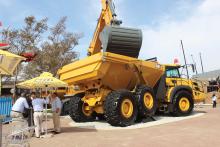
Two years after its acquisition by Volvo Construction Equipment, Terex Trucks is a re-energised company keen to embrace commercial opportunities in what remains a tough global quarrying and mining equipment market. Guy Woodford visited the the firm’s HQ in Motherwell, Scotland to learn more about how it is continuing to adapt to life alongside its Swedish parent company.
It’s 8.15am on Wednesday, 7th September and Paul Douglas tells me he’s got 45 minutes to talk before he needs to get to Glasgow International Airport to catch a flight to a business meeting at Volvo Group’s headquarters in Brussels, Belgium. The
“We were excited to be acquired by Volvo, as they were a very good owner to get,” he says. “Obviously the markets haven’t helped in terms of us proving what we can do. Volvo have been very true to their word. When they acquired this business they had a plan, a plan that wasn’t robust in terms of sticking to a timeline: ‘Year One, you will do this. Year Two, you will do that.’ It was initially about acquiring the business, then stabilising it, and then investment and growth, before, finally, looking to realise those investments.
“The acquisition went very smoothly. The stabilisation has led to Volvo fully understanding how this business works. What the cost structure of the business is like. What our breakeven point is. Where our strengths are. Where we need to improve. And where we needed to do more alignment to be part of the Volvo world – in terms of systems, environmental policy and safety policy.
“We now have an integrated quality management system that is getting a lot of plaudits within Volvo, and we are the first company in the UK – and second in the world - to obtain ISO 9001-2015 status. We are now also one of the first companies in the UK to get ISO 14001-2015 accreditation.
“We also now have a new HR SAP system, which is new for the whole of Volvo UK. And we are fully aligned with the Volvo Group warranty. Then there’s the new ‘Factory Master’ ERP system which is due to go live on 1st October. All this means we will be able to manage our business parameters and KPIs, exactly the same way as every other Volvo business.”
Unveiled at bauma 2016 in Munich, Germany the 38tonne Stage IV compliant TA400 is the largest and first of Terex Trucks’ new Generation 10 ADTs, and an example of Volvo CE’s investment and growth plan for the long-standing hauler manufacturer. The other Terex Trucks Generation 10 ADTs – the 28tonne TA300 and 25tonne TA250 - will be going into production before the end of the year.
The Stage IV system on the new ADT models features the latest generation Selective Catalytic Reduction (SCR), combined with Exhaust Gas Regeneration (EGR) technology and a Variable Geometry Turbo (VGT). Removing the need for a Diesel Particulate Filter (DPF) reduces customers’ total cost of ownership. Terex Trucks now offers fully compliant, cost-efficient haulers to all global markets.
To prolong hydraulic component lifecycles, all the new Generation 10 models have magnetic pressure filters that reduce the risk of contaminants entering the system. The filters also improve hydraulic oil cleanliness.
Meanwhile, the TA400, TA300 and TA25 are said to offer smoother and more productive hauling thanks to anti-vibration mounts for the engine and cabin. Cushioned stops on the steering cylinders are also integrated, and the cabin features an upgraded air conditioning and ventilation system.
Further improvements to the new Generation 10 ADTs are due to be unveiled at CONEXPO-CON/AGG 2017 in Las Vegas, U.S. 7-11 March 2017.
Another exciting facet of Volvo CE’s investment in Terex Trucks is the multi-million euro Terex Trucks Rigid Hauler Development Programme, with the first new model due to be unveiled to the market in 2018. “These will replace our four existing rigid haulers [TR45, TR60, TR70 and TR100],” says Douglas.
Manufacturing at Terex Trucks’ factory has also been enhanced in the past two years, with significant investment in new technology such as an induction hardening machine, coupled with upgrades of vital tools such as plasma cutters.
Terex Trucks, as a brand name is guaranteed until 2019, with the company working very closely with the Volvo Group to develop the correct brand strategy for its business, dealers and customers.
As Douglas alluded to earlier, the depressed state of the global quarrying and mining sectors has led to distributors for OEMs such as Terex Trucks fighting for every deal alongside those representing the traditional hauler heavyweight brands. “Even in deals for one or two trucks, you’re sitting down in the room with everyone else,” says Douglas.
“I’ve been in the [mining and quarrying] industry for 30 years and it’s definitely a lean time. There’s a malaise in the global economy. The Chinese slowdown is absolutely killing Asia. We sell rigid hauler kits to our partner in China, and production levels are well down.”
Looking at Terex Trucks’ ADT and below 105tonne class RDT markets, Douglas says what’s happening in China is having a knock-on effect in Africa, as a lot of Africa [mining and quarrying] minerals production goes to China, and, to a lesser extent, South America, currently in deep recession, with Brazil, its biggest single nation market, “way, way down” in its minerals production market.
“Russia has a particular geopolitical situation but its doing okay within its own market. Its coal production is as good as it’s been. They are also big exporters of coal just now, including to the UK, and we’re seeing some business picking up there,” says Douglas, noting how Terex Trucks is benefiting from joining Volvo CE’s
Switching his focus to the North American market, Douglas describes current hauler pricing in the U.S. as “crazy”, with no demarcation between value and premium brands. “If you look at the articulated hauler business in the Americas, particularly North America, it’s been dropping in the last 12 months. I think that’s due to the American presidential election coming up, and an uncertainty in commitment to big projects. Before that, there was some quite good quarry aggregate work going on linked to road building and general construction. There was also some good earthmoving projects.
“There were just over 4,000 articulated haulers sold annually in the United States and Canada up until a year ago. Now, it’s around 3,500 on a rolling annual basis. The decline is around 15% a year, and the decline is constant. We’re not sure where that’s going to bottom out. For the rigid truck business, North America mining is slowing down. Coal production is not a backbone of energy policy and most RDTs were sold into that. The market in the Americas is now around 450 trucks from previous highs of 800-900.”
Of Europe, Douglas says UK hauler demand for heavy earthmoving and infrastructure works had been doing quite well until the Brexit vote, which has created some investment uncertainty. “Spain has started to come back, which is interesting. But France is very slow. Germany’s hauler market is okay.” Douglas says Terex Trucks recently sold five TA300s 28tonne ADTs to Austrian contractor, Windsich, who are expanding the North Autobahn (A5) to create a modern highway between Vienna in Austria and Brno in the Czech Republic, Encouragingly, says Douglas, Windsich are interested in purchasing more haulers.
“We’ve also got interest in Scandinavia and Finland. We recently sold our first rigid truck into Norway through Volvo Maskin - a TR70 70tonne model to a granite quarry customer, and they are looking at buying another TR70 or even a 100tonne TR100,” he adds.
Given the tough global trading conditions, Douglas believes it’s a buyer’s market. “We have to compete. We have to reduce our costs in all areas and think what else we can offer with the products. We also have to do things with financing. Thankfully, we’ve got Volvo’s support with that now. We’ve had to reduce our production levels on our rigid haulers, and, unfortunately, that’s resulted in a [factory] headcount reduction.”
2011 was the last peak in global mining, quarrying and heavy earthmoving hauler demand, says Douglas, with Terex Trucks’ RDT and ADT sales currently down from these previous peaks. “What drives demand for aggregates, commodities and mined ores is human consumption. The world’s population is going to continue to grow, driving the need for homes, infrastructure and energy. The market has to turn, but when that turn will come no-one knows.”
Part of what puts Terex Trucks in a stronger position than some of its competitors to take advantage of growth anywhere in the world is its impressive 100-strong distributor network, covering around 110 countries – with 37 of those countries supported by Volvo CE distribution, and a further 15 or so planned to be moved to Volvo CE distribution in the next six months. This will make almost half of Terex Trucks’ sales territories aligned with Volvo CE distribution.
Douglas continues: “Among more recent heavyweight additions to Terex Trucks distribution network are Babcock International, who are selling the company’s full hauler range across Southern Africa.”
Volvo CE has also invested heavily in Terex Trucks’ aftermarket offer, boosting spare parts availability and dispatch, along with hauler fleet servicing capabilities. “Volvo has helped us understand better the management of our spare parts inventory, including what we should be keeping on our shelves. It’s meant a net increase in the total value of our inventory, and a substantial improvement in spare parts availability for vehicle off-road or stock orders from dealers. I could look back at 20 years of Terex Trucks records and availability has never been as high. We’ve gone from something like 82% stock order performance to something like 91%. In terms of vehicle off-road, it went from about 86% to about 95%, in terms of availability.
“We’ve also been promoting to dealers and customers the benefits of using genuine parts, and doing intense marketing of offers for competitive items such as filters, seals and bearings. While the mining market might be slow, with a lot of units parked up, we are still seeing a relatively healthy level of parts business. When the mining business picks up this should increase further.”
These might be tough times in the global quarrying and mining markets but one thing is for sure: its new product line-up, high quality manufacturing and impressive sales and hauler aftermarket capability has left Terex Trucks in pole position to meet increased hauler demand in the future.













